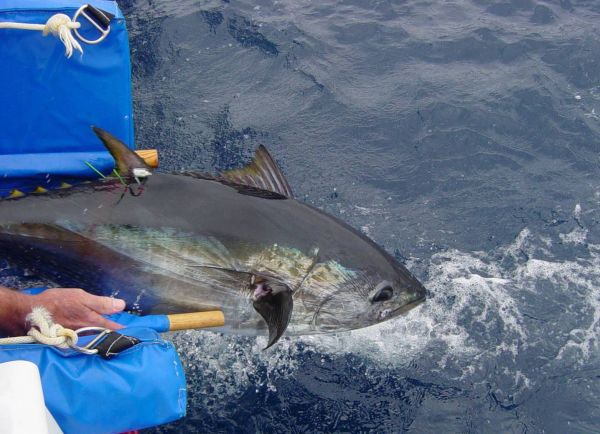Maps that show where sharks and tunas roam in the eastern Pacific Ocean, and where fishing vessels travel in this vast expanse, could help ocean managers to identify regions of the high seas where vulnerable species may be at risk.

By combining maps of habitats of marine predators, like this salmon shark, with satellite tracking of fishing fleets, researchers are identifying regions where they overlap. (Image credit: Scot Anderson, TOPP)
Researchers at Stanford University have created such a map by analyzing the habitats occupied by more than 800 sharks and tunas and 900 industrial fishing vessels. Focusing on international waters in the northeast Pacific, they found that vessels from Taiwan, China, Japan, the United States and Mexico accounted for over 90 percent of fishing in key habitat areas for seven shark and tuna species.
“The high seas are the global commons of the oceans,” said Timothy White, a graduate student in biology at Stanford and lead author of the paper detailing this research, published March 13 in Science Advances. “Analyses like this open the door to conversations about whether we think that the current mode of operation in the high seas is most equitable, most effective and most desirable.”
The researchers hope their findings can help the United Nations member states currently formulating the world’s first legally binding treaty to protect international waters, known as the high seas.
“We may protect a species near the coastline of North America, but that same species may be exposed to a high level of international fishing in the open ocean. By increasing the transparency of where fish and ship fleets meet, we can identify hot spots where international protection may be required,” said Barbara Block, the Prothro Professor of Marine Sciences at Stanford University.
Where fishing meets fish
The team’s work builds on a 2018 study led by Global Fishing Watch, the Block Lab and other researchers, published in Science. In that study, researchers took four years of data from the Automatic Identification System (AIS) – which tracks vessel movements via satellite – and developed a machine learning algorithm that mapped the footprint of 70,000 individual fishing vessels across the globe, down to details about the fishing methods of each vessel. In the current paper, the researchers narrowed their focus to the activities of over 900 vessels from 12 countries in the northeast Pacific Ocean to better understand the degree of overlap among fishing fleets, sharks and tunas in those waters.

A Pacific bluefin tuna is released with an archival tag from the eastern Pacific Ocean off the F/V Shogun in the California Current. (Image credit: Stanford University/B. Block)
Meaningful solutions to overfishing of some shark and tuna populations have been hindered by two significant mysteries: where fishing is happening and where the fish are. In order to help solve these mysteries, the researchers combined ship positions with the ocean habitat preferences obtained from the decade-long tracking program called Tagging of Pacific Predators (TOPP). This program included Pacific bluefin tuna, yellowfin tuna, albacore tuna, white shark, shortfin mako shark, salmon shark and blue shark. With the exception of the salmon shark, all of these species are currently listed as Threatened or Near-Threatened on the IUCN (International Union for Conservation of Nature) Red List of Threatened Species, though some populations are sustainably fished in the northeast Pacific region.
Over the 10 years of the TOPP program, 876 electronic tags were deployed on individual sharks and tunas. Hundreds of individual journeys – each spanning hundreds to thousands of kilometers – showed the researchers which areas of the ocean are preferred habitats for each species.
By integrating the animal, ship and environmental data, the researchers predicted what ocean regions and commercial fishing fleets have the highest overlap.
“The biggest challenge was in combining these very different datasets,” said White. “By adding the latest vessel tracking and machine learning techniques to the toolboxes of marine scientists, we were able to paint a clearer picture of how fish and fisheries interact, and this information can inform how our management strategies should reflect this.”
High seas protection
The United Nations’ high seas treaty discussions, which are ongoing through 2020, are very much on the minds of these researchers. As a window into human-animal interactions on the high seas, they believe their work could help guide which parts of the northeast Pacific Ocean deserve special consideration, what kinds of fishing activities should be addressed and what nations have a major role to play in protecting these waters.
“These analyses have given us the chance to look more deeply into the dynamics of this ocean and see where managers and stakeholders should focus their attention,” said Francesco Ferretti, a research associate at Stanford’s Hopkins Marine Station and co-author of the paper. “We need to push harder to preserve this corner of the planet because these are some of the best ocean environments in the world.”
Additional co-authors of the paper are David A. Kroodsma of Global Fishing Watch; Elliott L. Hazen and Steven J. Bograd of the National Oceanic and Atmospheric Administration and the University of California, Santa Cruz; Aaron B. Carlisle of the University of Delaware; and Kylie L. Scales of the National Oceanic and Atmospheric Administration and University of the Sunshine Coast. Block is also an affiliate of the Stanford Woods Institute for the Environment.
This research was funded by the Bertarelli Foundation, the National Science Foundation and the California Current Integrated Ecosystem Assessment Program.
To read all stories about Stanford science, subscribe to the biweekly Stanford Science Digest.
Media Contacts
Barbara Block, Hopkins Marine Station: (831) 655-6236, bblock@stanford.edu
Francesco Ferretti, Hopkins Marine Station: (831) 233-4905, ferretti@stanford.edu
Tim White, Hopkins Marine Station: (831) 655-6206, timwhite@stanford.edu
Taylor Kubota, Stanford News Service: (650) 724-7707, tkubota@stanford.edu